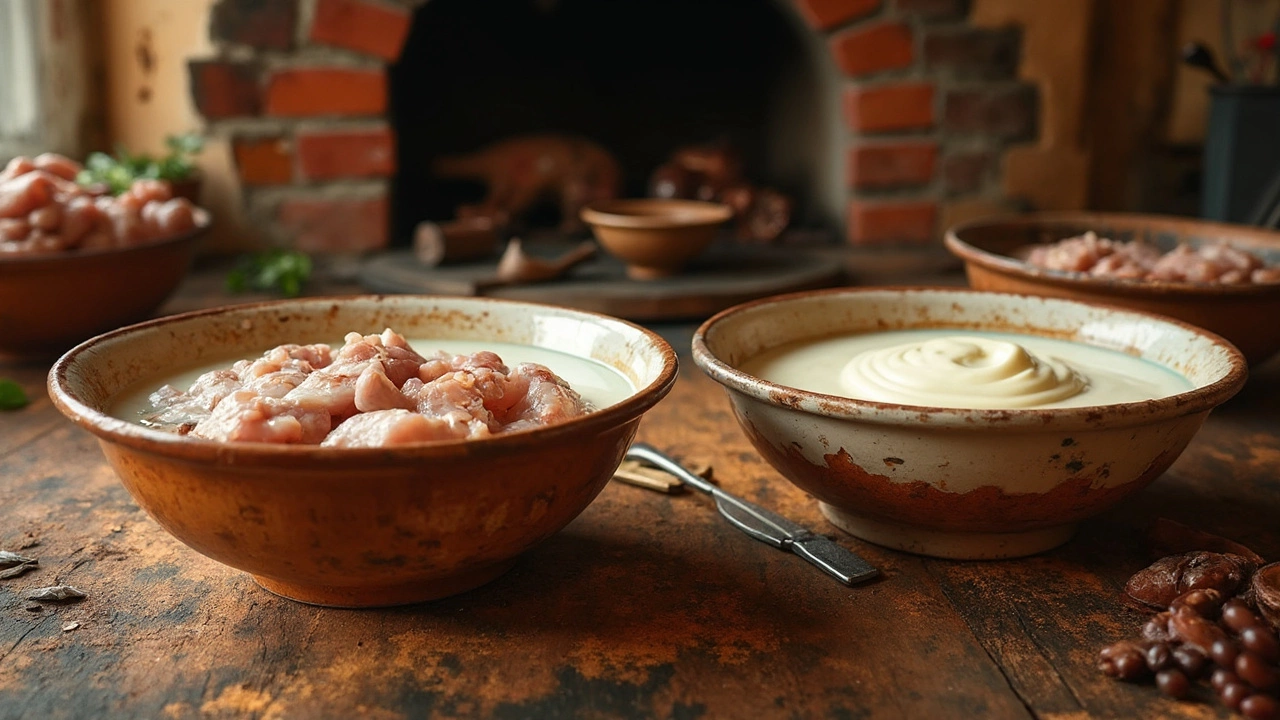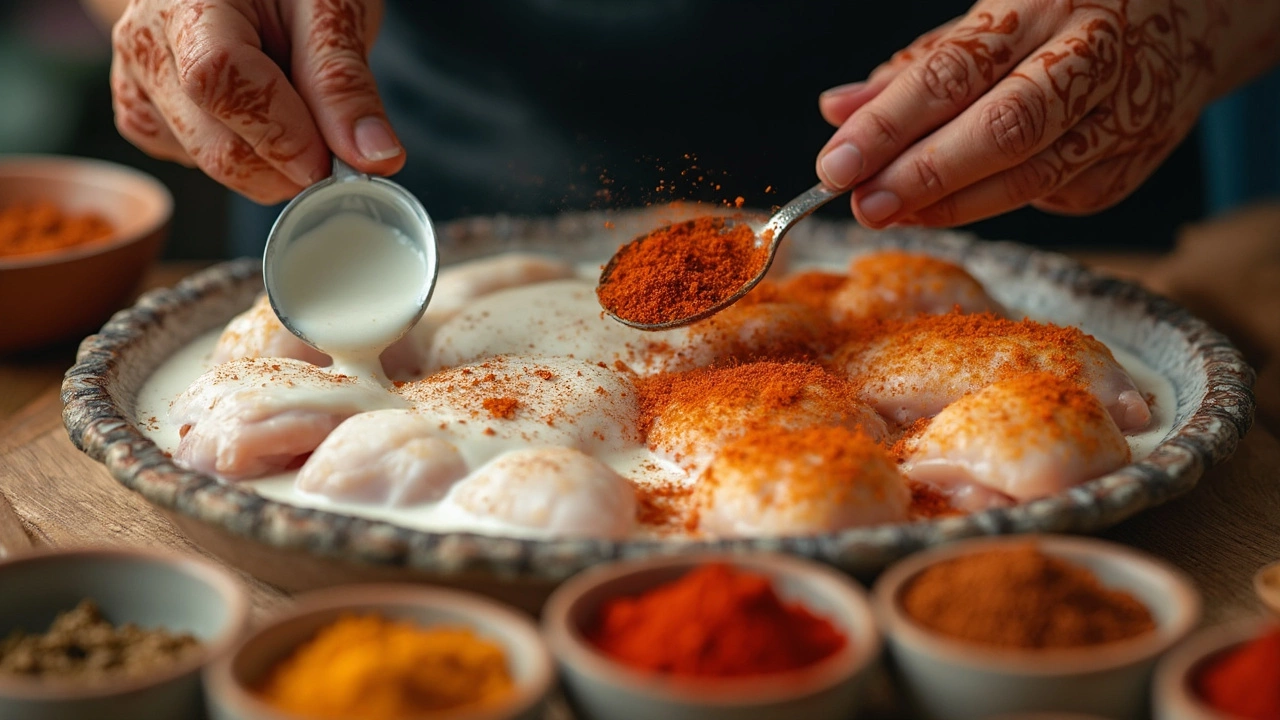Marinades are like the backstage crew of cooking; they may not be the stars, but they sure make the stars shine bright! When it comes to tandoori chicken, buttermilk and yogurt are among the top choices for marinades. But how do you decide which to use? Each one brings something different to the plate, quite literally.
Buttermilk has been a go-to tenderizer for generations. It's slightly acidic, which helps break down the proteins in the chicken, making it more tender and juicy. Plus, it's super forgiving even if you marinate the chicken overnight. On the other hand, yogurt has a natural creaminess and tanginess, perfect for adding richness to the dish. Its thicker consistency clings well to the spices, ensuring each piece is packed with flavor.
Curious about how this all plays out on your taste buds? Let’s uncover what makes each option unique and why one might be your better bet for tandoori chicken.
- The Role of Marinades
- Why Buttermilk?
- The Yogurt Advantage
- Comparing Flavors and Textures
- Practical Tips for Perfect Tandoori
The Role of Marinades
Marinades are the unsung heroes when it comes to flavoring and tenderizing meats. They work their magic, usually while you're off doing other things, transforming your basic ingredients into something extraordinary. In tandoori chicken, marinades are especially crucial for embedding that delicious spicy taste we all love.
What's in a Marinade?
At its core, a marinade is a mix of four main components: acids, oils, herbs/spices, and sometimes, dairy. The acid, often from lemon juice or vinegar, helps break down meat fibers, making the chicken tender. Oils help distribute the spices, ensuring each bite is flavorful. Now, when it comes to tandoori chicken, yogurt typically takes the lead role, adding a unique creaminess to the mix.
Power of Buttermilk and Yogurt
Buttermilk and yogurt are acidic and part of the dairy category, which makes them perfect for the job. Using buttermilk marinade is a traditional method for keeping chicken moist, particularly when using dry heat for cooking like a tandoor. On the other hand, a yogurt marinade offers a tangy zest and a thicker coating that means more spices stick to the chicken.
Beyond Flavor: Tenderizing
The science behind it is quite simple. The acids in buttermilk or yogurt begin to break down proteins in the chicken, which can help to make it more tender and succulent. This is key for tandoori, as the high heat can dry out meat if not properly marinated.
It's fascinating to note that these marinades are not just about taste. They play a big role in how the chicken cooks. If you're a fan of juicy, flavorful chicken, mastering the art of the marinade is a must!
Why Buttermilk?
Buttermilk has been a secret weapon in many kitchens for good reason. When you use it as a marinade for tandoori chicken, it does wonders. Here's the scoop on why buttermilk is a fantastic choice.
Super Tenderizer
The slight acidity in buttermilk acts like a gentle hammer, breaking down the chicken fibers. This makes the meat incredibly juicy and tender. Even if you let it sit in the fridge overnight, it won't go mushy. This leads to that melt-in-your-mouth texture we all crave.
Flavor Enhancer
While it might seem unlikely, buttermilk doesn't add a lot of its own flavor. Instead, it acts as a flavor enhancer. The subtle tang helps the spices in your marinade shine through, creating a balanced taste with every bite.
Easy Peasy Process
If you're all about simplicity, buttermilk is your friend. Just throw in your chicken, some spices, and buttermilk in a bowl or zip-lock bag. Boom, you’re done! Let it chill and do its magic. No babysitting required.
Additional Tips
- Fat Content Matters: Use full-fat buttermilk for richer results.
- Spice Soak: Enhance flavor by adding garlic, ginger, and chili powder directly to the buttermilk.
- Time It Right: Marinate for at least 4 hours, but overnight is best for deeper penetration.
With all these perks, buttermilk stands out not just as a tenderizer, but also as a remarkable enhancer of your tandoori chicken’s flavor profile. So the next time you're planning to whip up some tandoori chicken, maybe give buttermilk a go!

The Yogurt Advantage
Yogurt has been a staple in marinades for as long as we can remember, especially in Indian cooking. Adding yogurt to your tandoori marinade isn't just about tangy flavor; it's about chemistry. Yogurt's natural acidity, lactic acid, works wonders in tenderizing meat without making it mushy, which is always a plus when aiming for the perfect tandoori chicken.
One standout feature of yogurt is its thick consistency. This allows it to adhere well to the chicken and ensures that spices - think ginger, garlic, cumin, and chili - coat each piece thoroughly. The creaminess of yogurt also helps in balancing out the intense flavors of the spices, creating a harmony of taste with every bite.
What Makes Yogurt Special?
Beyond tenderizing, yogurt acts as a binding agent. It keeps the spices locked in place, which is crucial when cooking at high temperatures like you do with tandoori. This ensures that every piece of chicken has that same delicious coating throughout.
Nutritional Benefits
Yogurt isn't just a flavor enhancer; it also brings some nutritional perks. It contains healthy probiotics and calcium, which can be an added bonus if you're conscious about health.
Here's a sneak peek into what a typical tandoori marinade might look like with yogurt:
- 1 cup plain yogurt
- 2 tablespoons lemon juice
- 2 tablespoons ginger-garlic paste
- 1 teaspoon cumin
- 1 teaspoon coriander powder
- ½ teaspoon turmeric
- ½ teaspoon chili powder
- Salt to taste
Mix these ingredients, coat your chicken, and let it marinate for at least a few hours, preferably overnight. It's simple, flavorful, and offers that classic tandoori chicken taste many of us crave.
Comparing Flavors and Textures
When deciding between buttermilk and yogurt for your tandoori chicken, it really comes down to what you're looking for in terms of flavor and texture. Each marinade option gives a distinct characteristic to the dish, influencing the final taste and mouthfeel.
Flavor Profile
Buttermilk is known for its subtle tanginess that works beautifully with the spicy marinade typically used in tandoori chicken. It doesn't overpower the spices but rather complements them, allowing you to appreciate each spice note. On the flip side, yogurt brings a deeper tang and creaminess. This can enhance the spiciness, adding a slight sharpness that some might prefer for a more robust taste.
Texture
Texture is just as important as flavor! Chicken marinated in buttermilk turns out exceptionally tender and juicy. The buttermilk breaks down proteins and fibers in the chicken, ensuring it's succulent and easy to bite into. Yogurt, with its thick, rich consistency, not only coats the chicken in spices but also adds moisture. This makes the chicken soft but with a slightly richer mouthfeel compared to its buttermilk-marinated counterpart.
Quick Comparison
- Buttermilk: Mild tang, tenderizing effect, lighter texture.
- Yogurt: Stronger tang, coats well with spices, richer texture.
In the end, the choice is yours! Whether you go with buttermilk marinade for mellow flavors or the creamier kick from a yogurt marinade, both can bring out the magic in your tandoori recipe. It's about what tickles your taste buds the most!

Practical Tips for Perfect Tandoori
Ready to nail that tandoori chicken? Here are some tips to get that perfect blend of juicy insides with a smoky, spice-laden exterior. Whether you're rooting for buttermilk or yogurt as your go-to marinade, these pointers will elevate your tandoori game.
Marination Magic
First things first: give your chicken enough time to marinate. Both buttermilk and yogurt work best when you give them at least 4-6 hours. If you can plan ahead and let it sit overnight in the fridge, even better! This isn't just about soaking the meat; it's about flavor infusion.
"Longer marination times can improve tenderness and flavor complexity," says Chef Neha Shah, a culinary expert in Indian cuisine.
Spice it Up Mindfully
The fantastic thing about tandoori chicken is the spice mix. Common ingredients include garlic, ginger, cumin, and cayenne pepper. But feel free to adjust according to your taste. Maybe less heat for the kids?
Cooking to Perfection
When it comes to cooking, high heat is your friend. It gives that nice char while keeping the inside tender. If you're grilling, a medium to high flame does the trick; in the oven, preheat to about 425°F (220°C) and cook for about 20-30 minutes, turning halfway.
Check for Doneness
Nobody wants undercooked chicken. Use a meat thermometer if you have one. You're looking for an internal temperature of 165°F (75°C). If you don't have a thermometer, cut a piece to check that it's white and opaque all the way through.
Extra Touches
Before serving, squeeze some lemon juice and maybe garnish with fresh coriander. A dollop of mint chutney on the side never hurt anyone either!
